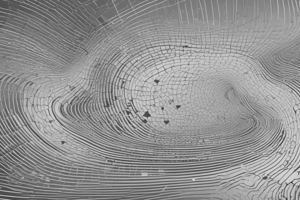Podcast
Questions and Answers
What is the result of adding two vectors of equal magnitude but opposite directions?
What is the result of adding two vectors of equal magnitude but opposite directions?
- A zero vector (correct)
- A vector of half the magnitude
- A vector of double the magnitude
- A vector of the same magnitude
Which of the following is a correct property of vector addition?
Which of the following is a correct property of vector addition?
- Vector addition is associative but not commutative
- Vector addition is commutative but not associative
- Vector addition is neither commutative nor associative
- Vector addition is both commutative and associative (correct)
What is the result of subtracting a vector from itself?
What is the result of subtracting a vector from itself?
- A vector of half the magnitude
- A vector of double the magnitude
- A zero vector (correct)
- A vector of the same magnitude
When adding two vectors, what happens to their magnitudes?
When adding two vectors, what happens to their magnitudes?
What is the difference between vector addition and scalar addition?
What is the difference between vector addition and scalar addition?
Flashcards are hidden until you start studying
Study Notes
Vector Addition Properties
- When adding two vectors of equal magnitude but opposite directions, the result is zero.
- A correct property of vector addition is that the order of the vectors being added does not change the result.
- Subtracting a vector from itself results in a zero vector.
- When adding two vectors, their magnitudes do not necessarily add; instead, the resultant vector's magnitude is generally smaller than the sum of the individual magnitudes.
- The key difference between vector addition and scalar addition is that vector addition takes into account both magnitude and direction, whereas scalar addition only involves the addition of magnitudes.
Studying That Suits You
Use AI to generate personalized quizzes and flashcards to suit your learning preferences.




